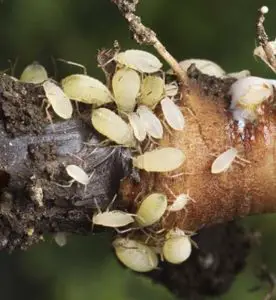Contents
Root aphids are cousins to green aphid species belonging to the family Phylloxera, which live beneath the ground surface and often contact the soil. They are major garden pests for an indoor grower, but they can also harm outdoor crops. In contrast to regular aphids, a root aphid infestation have a greater likelihood of killing your plants. Because aphid damage focuses on a plant’s root system, which supplies it with food, they cause significant damage. Since root aphids evolve so quickly, they are resistant to pesticides even during a crop cycle when pesticides are used. In addition to stunted growth, a sign of root aphids is droopy and yellow leaves, which seem to suggest nutrient deficiencies.
Battling A Root Aphid Problem
 Root aphids are very tiny (like spider mites) and color-coordinated to blend into the soil. A waxy substance left behind by root aphids is the primary sign of noticing their presence. Inspect your food crops for signs of a white, chalkier type of honeydew to determine if something undesirable is feeding on them.
Root aphids are very tiny (like spider mites) and color-coordinated to blend into the soil. A waxy substance left behind by root aphids is the primary sign of noticing their presence. Inspect your food crops for signs of a white, chalkier type of honeydew to determine if something undesirable is feeding on them.
In a similar fashion to mealybugs, root aphids have oval shape bodies. Because of their shape and the honeydew substance they leave behind, root aphids are often confused with mealybugs. They become winged aphids and are mistaken for fungus gnats when they are traveling to other plants. To identify aphids from these other pest insects, look for their tail pipes extending from their torsos.
Aphids that attack plant roots are highly destructive due to their ability to live indoors and outdoors. Whenever they are encountered outside, ants usually accompany them, which only compounds the problem and makes their eradication more difficult. Aphids transmit plant diseases by consuming and carrying the pathogens of plants they ingest.
Often, ants carry the eggs of root aphids which resemble beneficial soil fungus, to other areas, thereby spreading the problem. Once hatched, these species of aphids fall to the soil after hatching from their eggs, which can survive the winter beneath the soil, or they can attach to low-hanging stems and underside of leaves in the warm season allowing them to survive the winter.
The most common way they get into a system is through contaminated soil, soilless mix, coco coir, and other substrates. Aphid eggs are frequently found in commercial soils. It is probably best to avoid buying bagged soil if you want to avoid root aphid populations. Aside from this, don’t buy soil from large nurseries or import soil from unknown sources. Create your compost and soil whenever possible.
Getting Rid of Root Aphids
Plant Removal
To effectively treat root aphids on exhausted plants, the entire root part of the host plant must be removed and destroyed. It is not recommended to wait to see if the nursery plants still flower, produce fruit, or otherwise thrive because the longer the aphids remain, the more likely you to have infected plants. During removal, avoid shaking the garden plant or dropping aphids or eggs onto the soil or healthy plants below. Make sure to remove any dead plant matter. For a hydroponic garden system, such as deep water culture, take the plants out of their buckets, tubes, or other enclosures and examine them closely under magnification.
You can cook the soil to kill aphids if you do not want to remove the entire plant. You can remove the soil from an indoor garden by removing the plant and then the soil from the container. Bring soil to temperature on a baking sheet. On a sunny day, you can place a black tarp over the affected garden soil to achieve the same result. It is essential to verify that you successfully eliminated any remaining root aphids after applying this solution.
Insecticidal Soaps
It is not recommended to treat root aphids with insecticidal soaps. The reason for this is because they won’t kill any bugs under the soil. It is recommended that you use a natural insecticide such as neem oil or a pyrethrum-based foliar spray to treat your grow space, which will need to be used early during an active infestation. Spinosad-based insecticides can be watered into the soil, or Beauveria spores can be used to kill root aphids. For soil drench or hand water, most people recommend using 2 oz per gallon of water.
Sticky Traps
If root aphids are moving, yellow sticky traps will assist in catching them. Additionally, you can add beneficial nematodes during eradication to help exterminate these insects.
Beneficial Insects
Lastly, an effective biological control you can do is attracting predators such as birds that will pick the aphids off your outdoor gardens. Aphids above ground cannot reproduce without parasitic insects, such as parasitic wasps, predatory nematodes, and ladybugs.
Several other chemical insecticides get rid of aphids on contact. With adult crawlers, organic methods or natural methods are preferred since most chemical pesticides are only moderately effective.
Conclusion
It’s no doubt that attacks from root aphids can cause quite a bit of damage to indoor and outdoor plants if not detected early enough. Checking our plants every day is just one of the reasons why these creepy crawlers make us nervous! Following our guidance, keep the infestation under control as soon as you see signs that they have moved in. In the end, you are better off losing half of your garden than having to destroy half of your plants due to feeding aphids left unchecked.

